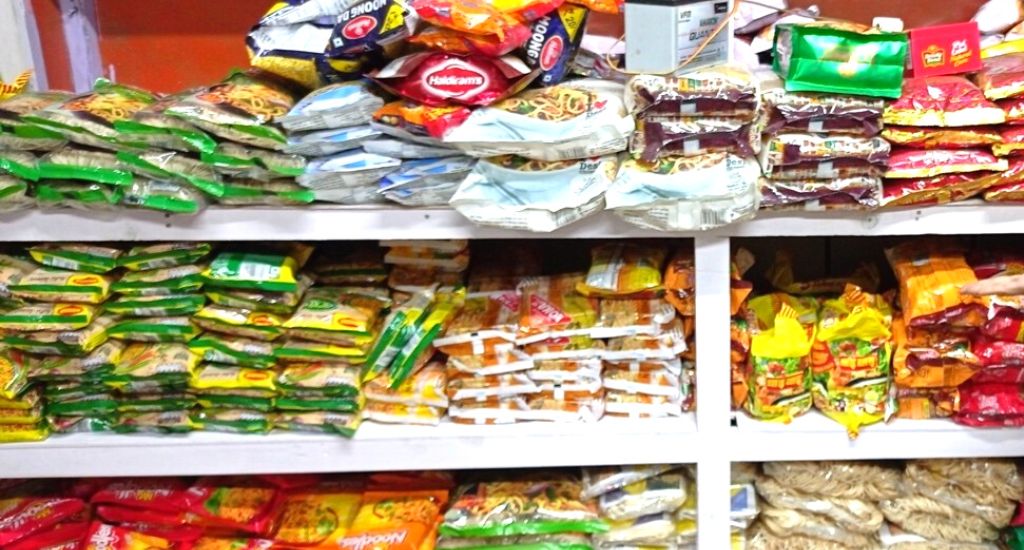Many of us have fond memories of drinking roohafza and eating homemade fryums.
OK, fryums are a deep-fried potato snack and roohafza might have fruit and herbs as its base but is loaded with sugar.
Still, being homemade meant they did not have the chemicals and preservatives of mass-produced snack foods. But being made at home also meant they were occasional treats as opposed to easily accessible junk food that has become ubiquitous in our cities.
There is now an endless range of new namkeen on offer – from potato or corn chips to “puffcorn” snacks made up of rice, lentil and corn.
But that is not all the processed foods that are easy access, tempting us when hunger hits.

There are both sweet and salty biscuits, never mind soupy noodles and we must not forget the crazy-wide array of candies and sweets – all now easily at reach from local stores to hawkers on street corners.
While India ranks 103 out of 119 countries on the Global Hunger Index, in just six years (from 2012 to 2018) the sales of packaged and processed foods in India doubled, according to Euromonitor International.
But it is a common misconception that most of this processed and packaged food is being consumed mostly by urban Indians.
Mass-produced namkeen and fast food lures rural Indians
The newly established Development Intelligence Unit (DIU) has found rural India consumes high amounts of processed fast food too.
Given that home is a principal point of consumption, a concentrated awareness campaign targeting parents is the likely way forward
DIU, a collaboration between the Sambodhi Panels and the Transforming Rural India Foundation, conducted a telephone-based survey across rural India covering 4,174 adolescent boys and girls aged 10-19 years (coverage of 2,117 aged 10-14 years and 2,057aged 15-19 years).
For the purpose of the study, the food items were divided into seven categories:
- biscuits
- instant noodles
- sliced bread
- chips and new namkeen snacks
- cold soft drinks
- chocolates and ice cream
- other sweets
These products are mainly composed of sugar, trans fat, salts with limited to almost zero amount of essential fibre, vitamins, iron and other nutrients. Studies time and again show that regular and increased consumption of processed foods is leading to an increase in the incidence of lifestyle diseases.
The fifth National Family Health Survey (NFHS) finds that there are more obese children (below 5 years old) than in 2015-16.

In order to stop Indians from becoming malnourished, it is crucial to find out what all Indians – not just those living in the cities – are eating and where they procure and consume this food.
Then better policies designed to help Indians eat better can be created.
What was the most loved processed food item for rural India?
When asked what food items from the seven categories were eaten in the past seven days, chips and easy foods like Kurkure were quoted the most, by 87.1% of the people surveyed, followed by biscuits according to 74.4%.
Nearly fifty percent of the respondents were also consuming sugary items, like Indian sweets, chocolates, ice cream or hard-boiled candy. How much? Around two to three times in the last 7 days.
This was followed by 40.6% saying they ate instant noodles twice a week.
Soft drinks were also consumed by nearly 30% of adolescents, around twice a week.

Surprisingly, the least eaten processed food product is sliced bread.
“We have observed that processed food, especially the junk food, has penetrated the villages. Interestingly, it’s not the global brands that are popular – some with almost no adherence to quality standards. These are extremely high in sugar, salt and fat. Ample anecdotal evidence shows us these food items are leading to the double burden of malnutrition where we’also dealing with obesity along with the prevailing malnutrition,” said Sayan Deori, a Community Nutrition Practitioner from Nutrition and Community Action Resource (NCARe) Centre, Tezpur University.
When and where is processed fast-food eaten?
Digging deeper the survey found younger people aged 10-19 were most often eating these ‘fast food’ products at home with overwhelmingly four out of the seven fast food items, the major share of the consumption took place at home.
We need stricter policies to regulate these processed food markets
Soft drinks and sweets, to a lesser extent, were offered at a friend or relative’s home.
But the salted namkeen snacks were eaten almost everywhere – both in and out of school as well as at home.
“Updated national level surveys on diet diversity and food system mapping are very important to know how and what is the consumption style. We also need stricter policies to regulate these processed food markets,” Deori added.
Home cooked food being replaced by unhealthy snacks
With the prevalence of processed foods widely available, governments should take such findings into account when drafting food and nutrition policies.

Already the World Bank has advocated that unhealthy foods, like soft drinks and high-fat foods, be taxed higher and that mandatory front-of-package labelling be put on processed foods.
Sandeep Ghosh, DIU’s Team Lead, thinks it is time for India’s policy makers to do more too.
“Given that home is a principal point of consumption, a concentrated awareness campaign targeting parents is the likely way forward,” Ghosh said.
(Read more: New survey shows processed snack foods lure rural Indians)
The lead image at the top shows a variety of processed foods in a store shelf (Arundhati Sathe, Unsplash)
Kankana Trivedi is a manager at Development Intelligence Unit (DIU) and interested in environment and social justice issues.








